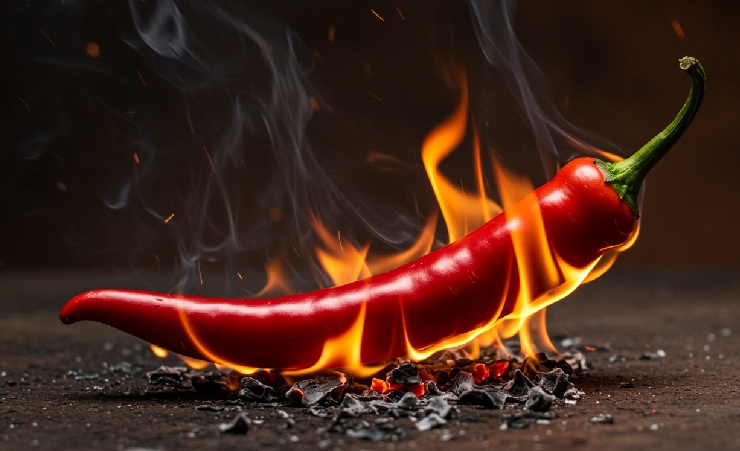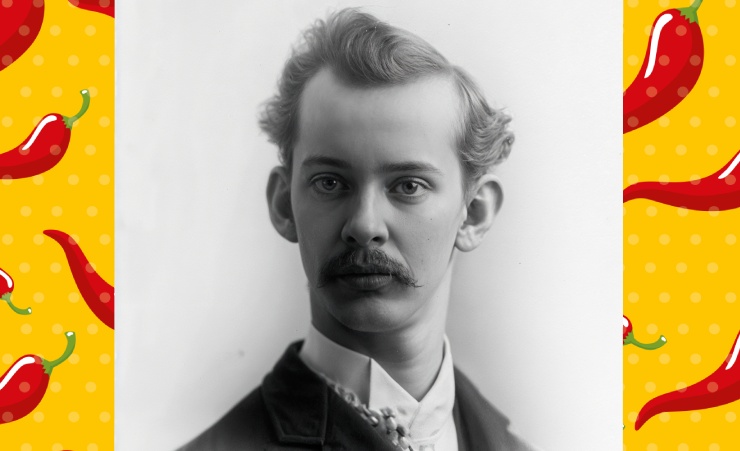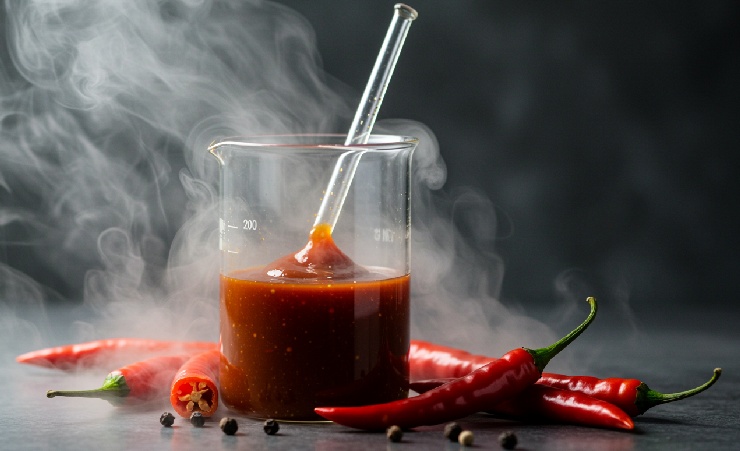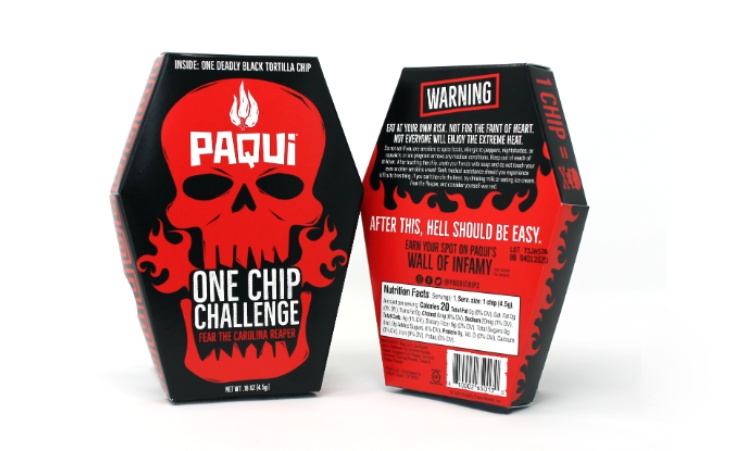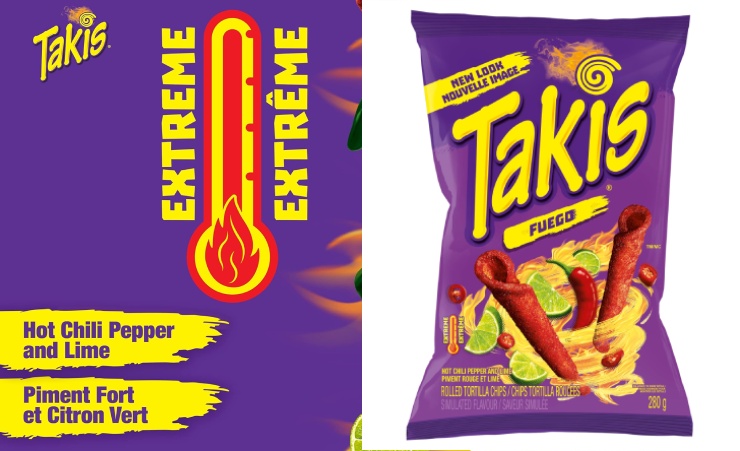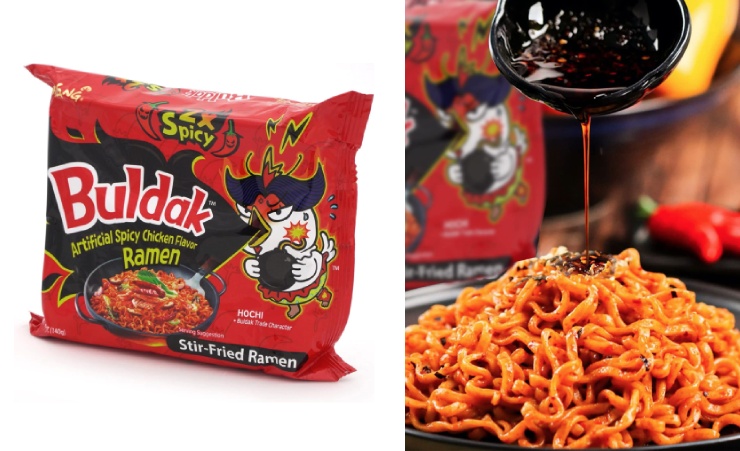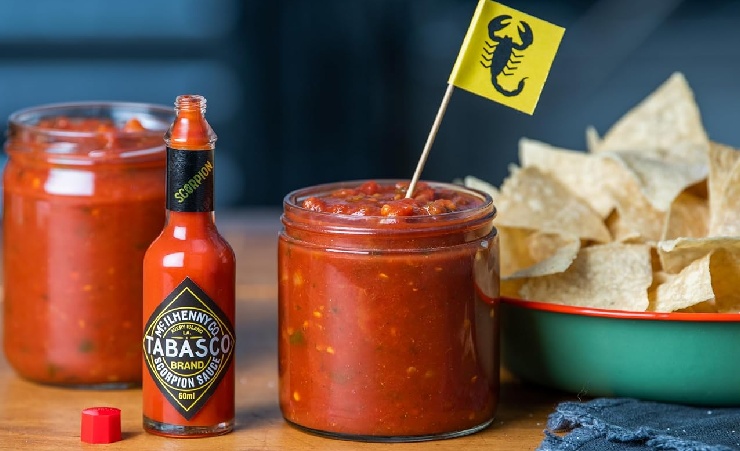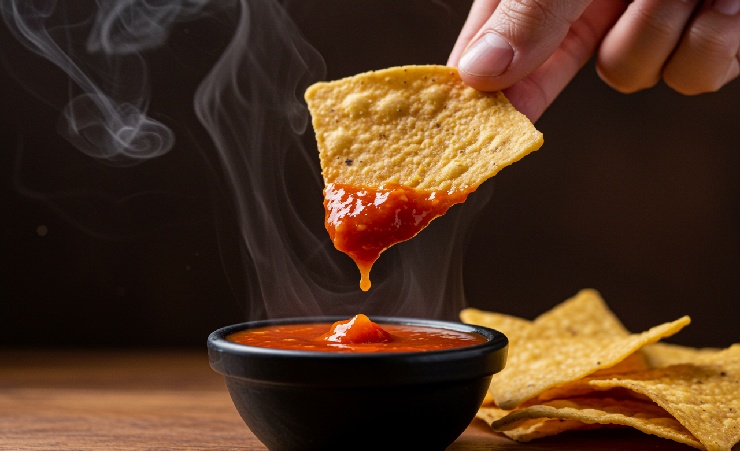Updated on March 10th, 2025
Have you ever wondered why a Carolina Reaper can make grown adults cry while a jalapeño gives a mild tingle? Thanks to the Scoville Heat Unit (SHU), the universal scale for measuring spice, that’s all. But what does it mean when a hot sauce claims to be 2 million SHU? Is that just marketing, or is your tongue genuinely in for a world of pain?
Measuring spiciness isn’t just about bragging rights. It is crucial in culinary science, medical applications, and cultural traditions. Capsaicin—the fiery compound behind a pepper’s heat—has been used in pain relief creams, military-grade pepper spray, and the ever-growing world of hot sauces. Understanding the Scoville Scale helps you pick the right heat level for your food (or spice tolerance).
So, let’s break it down—where did this scale come from, and how does it work?
Origins of the Scoville Scale
Who Is Wilbur Scoville (1912)
The Scoville Scale was invented over a century ago by Wilbur Scoville, a chemist working for Parke-Davis Pharmaceuticals. Funny enough, he wasn’t trying to create a spice ranking for daredevil eaters—he was developing a pain-relief ointment. While studying capsaicin’s numbing effects, he needed a way to measure just how potent different peppers were. Enter the Scoville Organoleptic Test.
Scoville’s original method was painfully subjective. He had a panel of five human tasters sample increasingly diluted pepper extracts mixed with sugar water. The process continued until the heat was no longer detectable. The number of dilutions determined the SHU rating—for example, if a pepper needed to be diluted 10,000 times before losing its heat, it was ranked at 10,000 SHU.
Why the Old System Had Issues
- Human error: Spiciness perception varies, and testers’ tolerance levels could skew results.
- Huge variability: Some SHU ratings fluctuated by ±50%, depending on the panel.
- Burnout (literally): Tasting ultra-hot peppers for science sounds noble—until you realise these testers were human guinea pigs for mouth pain.
Despite its flaws, Scoville’s scale survived. Thankfully, modern science has found a much more precise way to measure heat that doesn’t require torturing taste testers. (More on that next!)
How the Scale Works Today
Back in Wilbur Scoville’s day, measuring heat meant relying on the burned-out taste buds of a few brave souls. Luckily, modern science has upgraded the process. Today, the Scoville Scale is powered by High-Performance Liquid Chromatography (HPLC), a fancy lab method that gives precise SHU readings without human suffering.
The Science Behind Scoville Measurements
HPLC works by detecting the capsaicinoids (the fiery chemicals in peppers) and measuring them in parts per million (ppm). From there, a simple formula converts this data into Scoville Heat Units:
So, a sauce with 100 ppm of capsaicinoids scores 1,600 SHU. Simple, right? Well, not quite—because nature loves a little unpredictability.
Why Scoville (SHU) Ratings Can Vary
- Pepper Batches Differ – A jalapeño can be a mild 2,500 SHU or a fiery 8,000 SHU, depending on weather, soil, and ripeness.
- Extract-Enhanced Sauces – Some hot sauces cheat by using pure capsaicin extract, which can crank up their heat into the millions (way beyond what nature intended).
That’s why you’ll often see SHU ranges instead of exact numbers. Your bottle of Tabasco (2,500–5,000 SHU) might be mild today, but next week’s batch could pack an unexpected punch.
Scoville Rating Chart
Not all peppers are created equal. Some barely register on the Scoville Scale, while others can ruin your afternoon with a single bite. Here’s a breakdown of where different Scoville rating for:
| Pepper/Sauce | Scoville Units (SHU) | Heat Level |
|---|---|---|
| Bell Pepper | 0 | Neutral |
| Poblano | 1,000–1,500 | Mild |
| Jalapeño | 2,500–8,000 | Medium |
| Bird’s Eye Chilli | 50,000–100,000 | Hot |
| Cayenne | 30,000–50,000 | Hot |
| Habanero | 100,000–350,000 | Extreme |
| Carolina Reaper | 1.4M–2.2M | Superhot |
| Pepper X | 3.18M | Superhot |
| Pure Capsaicin | 16M | Lethal |
Just a quick note: Da Bomb Beyond Insanity Hot Sauce is a whopping 135,600 Scoville, and it’s already super hot. And if you want, we have another hotter sauce called Blair’s Mega Death Sauce, which is 550,000 Scovilles for an insane heat stroke.
Hot Sauce Showdown
Let’s put some famous hot sauces on the scale:
Whether you want a gentle heat or a full-on spice apocalypse, the Scoville Scale helps you choose wisely. But beware—numbers don’t always prepare you for the pain. Even a seemingly “reasonable” SHU rating can feel brutal if the heat builds over time (looking at you, ghost peppers).
Enhanced Heat Perception Guide
Spice lovers often turn to the Scoville chart to compare peppers, sauces, and spicy snacks. But what do those numbers actually mean in real-life heat perception? Let’s break it down into something more relatable—because knowing the Scoville units of a jalapeño is one thing, but feeling the burn is a whole different experience.
Scoville in Real Life: How Long Does the Burn Last?
Not all heat is created equal. Some peppers give you a quick, sharp burn that fades fast, while others stick around for what feels like an eternity. Here’s a Scoville scale comparison of common spicy items, plus how long you can expect to suffer (or enjoy) the heat.
| Item | Scoville Range | Equivalent Heat Experience | Burn Duration |
|---|---|---|---|
| Bell Pepper | 0 | Completely mild, with no heat | Instant relief |
| Jalapeño | 2,500–8,000 | Spicy salsa, slight lip tingle | 15–30 sec |
| Tabasco Sauce | 2,500–5,000 | Hot wings with a lingering burn | 30 sec–1 min |
| Sriracha | 2,200 | Mild, sweet heat | 30 sec |
| Habanero | 100,000–350,000 | Intense, stinging spice | 5–10 mins |
| Carolina Reaper | 1.4M–2.2M | 45-min full-body heat wave | 30–45 mins |
| Police Pepper Spray | 2M–5.3M | Immediate incapacitation | 15+ mins (agonising) |
Why Pepper Spray Isn’t the Hottest on Earth
Surprisingly, pepper spray isn’t technically the hottest substance out there. While its Scoville of 2M–5.3M Scoville makes it a nightmare for the eyes and skin, some hot sauces and pure capsaicin extracts go even higher—up to 16M Scoville (pure capsaicin itself). However, pepper spray is designed to be unbearable, meaning even lower Scoville ratings can feel far worse than eating a spicy pepper.
The Science of Spice
So, what exactly makes peppers burn? It all comes down to capsaicin, the active compound responsible for that fiery sensation. But here’s the kicker: it’s not “hot” in the traditional sense. Your mouth isn’t burning—your brain just thinks it is.
Capsaicin’s Fiery Trick
Capsaicin binds to TRPV1 receptors, the same pain receptors that detect actual heat (like when you touch a stove). Your brain, convinced you’ve just swallowed molten lava, kicks into emergency mode. This leads to:
- Sweating – Your body’s way of “cooling down” (even though there’s no real heat).
- Endorphin Rush – A natural painkiller, which explains why some people get a “spicy high.”
- Runny Nose & Tears – Your body is trying to flush out the “threat.”
Medical Uses of Capsaicin
Ironically, the same compound that makes you feel like you’re dying is also used for pain relief. Low doses of capsaicin (0.025–0.1%) are found in:
- Topical creams for arthritis and nerve pain.
- Nasal sprays to relieve chronic headaches.
- Patches used in clinical treatments for nerve disorders.
The initial burn makes Your body so overwhelmed that it stops registering pain altogether. (Who knew spicy food could double as pain therapy?)
Commercial Products for Chili Adventures
If you want to test your spice tolerance (or watch your friends suffer), there are plenty of fiery snacks and sauces to try. Here’s a quick rundown of some of the hottest and most notorious spicy products on the market.
Paqui One Chip Challenge
This isn’t just a snack—it’s an experience (and not always a pleasant one). The Paqui One Chip Challenge features a single tortilla chip coated in a brutal mix of Carolina Reaper and Naga Viper peppers, with a Scoville rating between 1.6M and 2M SHU. Expect immediate pain, a possible endorphin rush, and around 15 to 45 minutes of pure regret. Pro tip: Keep dairy nearby—water won’t save you.
Takis Fuego
Spicy, crunchy, and tangy, Takis Fuego is an addictive (far less terrifying) way to enjoy some heat. Made with chilli-lime seasoning, they clock in at 8,000–12,000 SHU, roughly the same as a jalapeño. They won’t melt your face off, but they will make your fingers look like they’ve been dipped in nuclear fallout. It’s great for casual snacking or tricking spice newbies into thinking they can handle hotter foods.
Buldak 2x Spicy Ramen
Korean Samyang Buldak Ramen is infamous among spice lovers, with the 2x Spicy version reaching 12,000–20,000 SHU. This isn’t your typical instant noodle; it’s a sweat-inducing, tear-generating fire bowl. The sauce contains ghost pepper extract, ensuring the burn lingers long after the last bite. Add cheese or an egg to tame the heat (or suffer in silence like the rest).
Tabasco Scorpion Sauce
If regular Tabasco isn’t cutting it anymore, Tabasco Scorpion takes things up a notch—or twenty. Made with Scorpion peppers (one of the world’s hottest), this sauce hits between 30,000 and 50,000 SHU. It’s a slow burn, with a sweet and tangy start before the fire begins. Perfect for spicing up tacos, wings, or anyone who underestimates your heat tolerance.
| Product | SHU Range | Key Pepper Used |
|---|---|---|
| Paqui One Chip | 1.6M–2M | Carolina Reaper Blend |
| Takis Fuego | 8,000–12,000 | Chili-Lime Extract |
| Buldak 2x Spicy | 12,000–20,000 | Ghost Pepper |
| Tabasco Scorpion | 30,000–50,000 | Scorpion Pepper |
Safety Tips for Spice Challenges
Are you thinking about attempting a spicy challenge? Here are a few things to keep in mind:
Pepper Variability Expansion
Not all peppers are created equal—heat levels can fluctuate wildly, even within the same variety. If you’ve ever bitten into a jalapeño expecting a mild kick and ended up with your mouth on fire, here’s why.
Why Jalapeños Vary (2,500–8,000 SHU)
Jalapeños sit between 2,500 and 8,000 Scoville Heat Units (SHU), but the actual spice level depends on a few key factors:
🔥 Soil pH Impact – Jalapeños thrive in slightly acidic to neutral soil (pH 5.5–7.0). Peppers grown in more acidic or nutrient-rich conditions often develop higher capsaicin levels, making them spicier.
🍃 Ripeness Variance – Green jalapeños (picked early) are milder and slightly grassy, while red jalapeños (fully ripened) pack more heat and sweetness. If you want a spicier jalapeño, go for the red ones.
Ghost Pepper Variants
The notorious Ghost Pepper (Bhut Jolokia) normally hits 800,000–1,041,427 SHU, but different strains can be even hotter. Some hybrid variants—like the Chocolate Ghost Pepper or Peach Ghost—have unique flavours and even higher heat levels, sometimes surpassing 1.2M SHU.
Controversies and Criticisms
Not everyone enjoys the modern hot sauce arms race, in which brands compete to create the next “hottest sauce ever.” Some argue that these ultra-hot, extract-based sauces aren’t real food anymore—they’re just chemically engineered torture devices.
The Extract Debate
Traditional hot sauces rely on actual peppers, while some of today’s hottest sauces (like those claiming 16M SHU) use pure capsaicin extract. Critics say this distorts the natural balance of flavour and heat. After all, there’s a difference between:
- A well-crafted habanero sauce that enhances a dish.
- A bottle of capsaicin extract designed to melt your soul.
Cultural Clashes: Gimmick vs. Authentic Heat
There’s also a debate about hot sauce authenticity. Many traditional cultures have used spice for centuries (think Mexico’s Cholula, Thailand’s Sriracha, or India’s ghost pepper chutneys). Some argue that ultra-hot sauces made for shock value overshadow these time-tested, flavour-packed recipes.
Is Extreme Heat Dangerous?
In some cases, yes. There have been reports of people getting hospitalised after consuming insanely hot sauces. Symptoms include:
- Throat constriction.
- Severe stomach pain (capsaicin is a gut irritant).
- Vomiting & dehydration (your body doesn’t want that much spice).
Of course, most people won’t end up in A&E from a dab of hot sauce, but if you’re chugging a bottle of 3M SHU sauce for internet clout, you should rethink your life choices.
Global Heat Trends
Hot sauce isn’t just a niche obsession—it’s a global phenomenon. From Mexican salsas to Korean gochujang, spicy condiments are booming in popularity. The hot sauce industry is projected to hit $4.38 billion by 2028 (thank you, spice addicts).
Cultural Hot Sauce Icons
Different regions have their legendary heat sources:
🔥 Cholula – 3,600 SHU
A balanced mix of heat and flavour.
🌶️ Sriracha – 1,000–2,500 SHU
The king of spicy condiments.
🔥 Bhut Jolokia (Ghost Pepper) – 1M SHU
Once the world’s hottest pepper.
💀 Moruga Scorpion – 2M SHU
So hot it can blister skin.
Meanwhile, pop culture is fueling the spice craze. Shows like Hot Ones have made ultra-hot sauces a status symbol—if you can handle them, you earn serious bragging rights.
Spice on the Rise
Why is the world getting hotter (food-wise)? A few reasons:
- Social Media Challenges – Watching people suffer on camera never gets old.
- Health Benefits – Some studies suggest capsaicin boosts metabolism and reduces inflammation.
- Adventure Eating – People are constantly chasing bolder, more intense flavours.
So, whether it’s for culinary love or pure masochism, one thing’s clear: the world isn’t cooling down anytime soon.
Practical Tips for Heat Lovers
Ready to turn up the heat? Here are some essential tips for new spice or seasoned fire-breathers.
Handling Super-Hot Peppers
Chopping a Carolina Reaper bare-handed? Bad idea. Capsaicin doesn’t just burn your mouth—it lingers on your skin (and worse, your eyes). Avoid disaster with these steps:
✅ Wear gloves – Trust us, soap won’t cut it.
✅ Use oil to remove residue – Capsaicin is oil-soluble, so rub your hands with olive oil before washing.
✅ Keep hands away from your face – Unless you enjoy crying uncontrollably.
How to Cool the Burn
Water won’t help—it just spreads the pain. Instead, try:
🥛 Dairy – Casein in milk binds to capsaicin and washes it away.
🍚 Starches – Rice, bread, or tortillas help absorb the heat.
🍋 Acidic foods – Lemon juice or vinegar can neutralise some burn.
Pairing Heat with Food
Want to add spice without ruining your meal? Match your sauce’s SHU to the dish:
Spice is all about balance—too much heat, and you’ll lose all the flavour. Unless, of course, you want to prove a point. (We won’t judge.)
Related Posts
The original DadShop writer, owner, fun loving and tech guy. Great with computers, gadgets, quick on his feet and lover of novelty gifts. Ben writes for our wonderful blog occasionally just to pass time.

